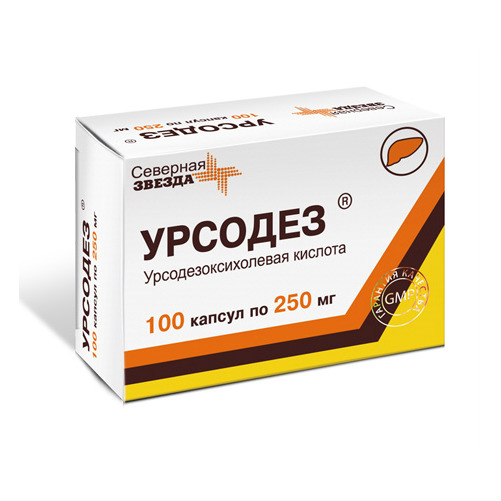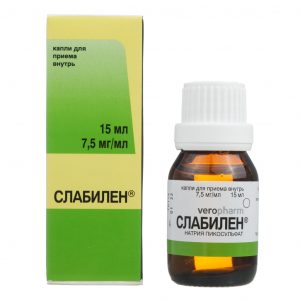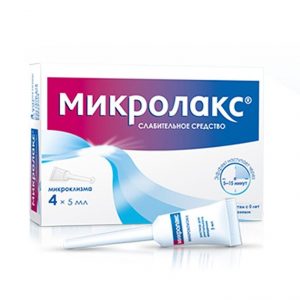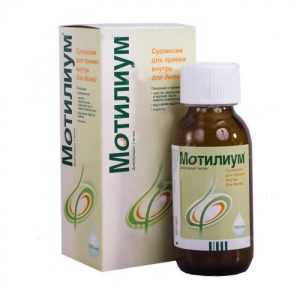Description
Latin name
Ursodez
Release form
Capsules
Packing
100 capsules
Pharmacological action
PHARMACOTHERAPEUTIC GROUP OF THE MEDICINAL PRODUCT:
Hepatoprotective agent
ATC CODE: [A05AA02]
Pharmacologic drug-resistant drug It reduces the synthesis of cholesterol in the liver, its absorption in the intestine and concentration in bile, increases the solubility of cholesterol in the biliary system, stimulates the formation and secretion of bile.
Reduces the lithogenicity of bile, increases the content of bile acids in it, causes an increase in gastric and pancreatic secretion, enhances lipase activity, has a hypoglycemic effect. Causes partial or complete dissolution of cholesterol stones during enteral use, reduces the saturation of bile with cholesterol, which helps mobilize cholesterol from gallstones.
It has an immunomodulatory effect, affects the immunological reaction in the liver: it reduces the expression of certain antigens on the hepatocyte membrane, affects the number of T-lymphocytes, the formation of interleukin-2, reduces the number of eosinophils.
Pharmacokinetics
Ursodeoxycholic acid (UDCA) is absorbed in the small intestine by passive diffusion (about 90%), and in the ileum by active transport. After oral administration in a single dose (500 mg), the maximum concentration in the blood serum (Cmax) after 30, 60, 90 min is 3.8, 5.5, 3.7 mmol / L, respectively. Communication with plasma proteins is high – up to 96-99%.
Crosses the placental barrier. With systematic administration, ursodeoxycholic acid becomes the main serum bile acid (48% of the total bile acid content). The therapeutic effect of the drug depends on the concentration of UDCA in bile.
Metabolized in the liver (clearance during the initial passage through the liver) to taurine and glycine conjugates. The resulting conjugates are secreted into the bile. About 50-70% of the total dose is excreted through the intestines. A small amount of non-absorbable ursodeoxycholic acid enters the large intestine, where it is digested by bacteria (7-dehydroxylation), the resulting lithocholic acid is partially absorbed from the colon, but sulfates in the liver and is rapidly excreted in the form of a sulfolithocholylglycine or sulfolithocholyltaurin conjugate.
Indications
dissolution of cholesterol gallstones
primary biliary cirrhosis, with no signs of decompensation (symptomatic therapy)
biliary reflux gastritis
chronic hepatitis of various genesis
primary sclerosing cholangitis
cystic fibrosis (mucoviscidosis)
nonalcoholic steatohepatitis
alcoholic liver disease
dyskinesia biliary tract.
Contraindications
Hypersensitivity to the components of the drug
pancreatitis
pregnancy
lactation
adults and children weighing up to 34 kg.
Use during pregnancy and lactation
The drug is contraindicated during pregnancy and lactation.
Composition
1 capsule contains:
active ingredient:
ursodeoxycholic acid – 250 mg,
excipients:
pregelatinized starch (1500 starch) – 73.0 mg,
silicon dioxide syld 5 colloid dioxide magnesium stearate – 2.0 mg,
capsule shell:
titanium dioxide,
gelatin
Dosage and Administration
Inside.
Dissolution of cholesterol gallstones
The recommended (approximate) dose is 10 mg of ursodeoxycholic acid per 1 kg of body weight per day. The drug must be taken daily in the evening, before bedtime (capsules do not chew), washed down with a small amount of liquid. The duration of treatment is 6-12 months. For the prevention of re-cholelithiasis, the drug is recommended for several months after the dissolution of the stones.
Treatment of biliary reflux gastritis
1 capsule of the drug Ursodez daily in the evening before bedtime, with a little water. The course of treatment is from 10-14 days to 6 months, if necessary – up to 2 years.
Symptomatic treatment of primary biliary cirrhosis
The daily dose depends on body weight and ranges from 2 to 6 capsules (about 10 to 15 mg of ursodeoxycholic acid per 1 kg of body weight) in 2-3 doses.
For chronic hepatitis of various origins, non-alcoholic steatohepatitis and alcoholic liver disease
The average daily dose is 10 to 15 mg of ursodeoxycholic acid per 1 kg of body weight in 2-3 doses. The duration of therapy is 6-12 months or more.
With primary sclerosing cholangitis, cystic fibrosis (cystic fibrosis)
The average daily dose is from 12 to 15 mg of ursodeoxycholic acid per 1 kg of body weight, if necessary, the average daily dose can be increased to 20-30 mg per 1 kg of body weight in 2-3 reception. The duration of therapy is from 6 months to several years.
For biliary dyskinesia
The average daily dose is 10 mg of ursodeoxycholic acid per 1 kg of body weight in 2 divided doses for 2 weeks to 2 months. If necessary, the treatment should be repeated.
Side effects
Diarrhea, nausea, pain in the epigastric region and right hypochondrium, calcification of gallstones, increased activity of hepatic transaminases, allergic reactions.
In the treatment of primary biliary cirrhosis, transient decompensation of cirrhosis of the liver may occur, which disappears after discontinuation of the drug.
Overdose
No overdose has been detected. In case of overdose, symptomatic treatment is performed.
Storage conditions
In a dry, dark place, at a temperature not exceeding 25 ° C.
Expiration
5 years.
Deystvuyuschee substances
ursodeoxycholic acid
Terms of delivery from
pharmacies Prescription
dosage form
dosage form
capsules




